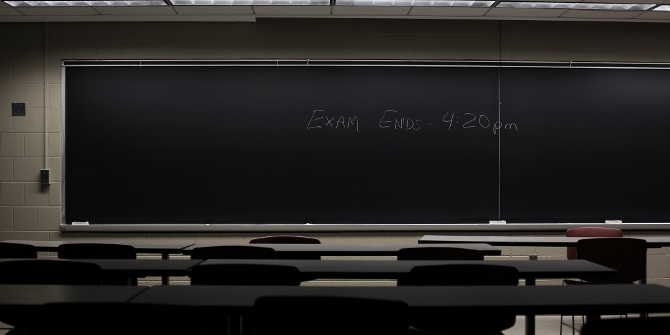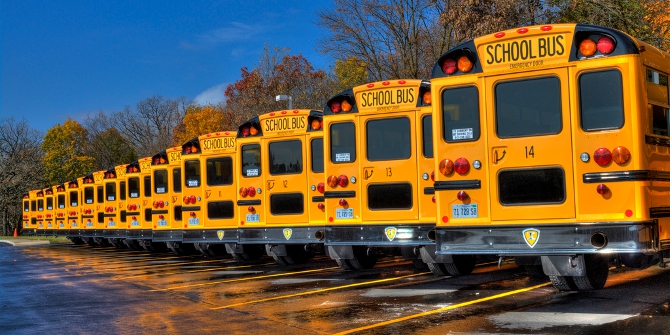 Last week, President Obama announced that community college will be made free for all students for the first two years of study. Sara Goldrick-Rab welcomes the announcement, which will be especially helpful for less affluent families who spend a large proportion of their family income on college. She writes that the next steps in improving college affordability should include making the first two years of college free at four-year colleges and universities, increases in per-student funding, and coverage of students’ living expenses, books, and supplies.
Last week, President Obama announced that community college will be made free for all students for the first two years of study. Sara Goldrick-Rab welcomes the announcement, which will be especially helpful for less affluent families who spend a large proportion of their family income on college. She writes that the next steps in improving college affordability should include making the first two years of college free at four-year colleges and universities, increases in per-student funding, and coverage of students’ living expenses, books, and supplies.
As an educational policy scholar, I am thrilled that President Obama has said the words “free” and “college” in the same sentence. The plan he announced on January 9th to make community college free for all students is a good one, and the need for it is growing increasingly urgent with each passing semester.
As wealth inequality expands at the state and national levels, family income becomes tied ever closer to the chances of earning a post-secondary degree. The higher a family’s income, the greater the odds that a college degree will be attainable. The lower a family’s income, the more remote the chances of anyone in that family entering and completing a two- or four-year college degree program. Compounding the problem is the convergence of skyrocketing college costs and the ineffective allocation of federal and state financial aid funding. This means that students from less-affluent families are already paying — and will continue to pay – a growing proportion of their family income toward that degree.
Today, for example, the amount a low-income family pays for a family member to attend community college can be as much as 40 percent of the family income. For four-year colleges, college costs can rise to a jaw-dropping 59 percent of a family’s earnings. Middle-class families are squeezed, as well. They may have to spend or borrow a full quarter of their annual income to send just one student to a public university, and even more to send that student to a private university.
As a result, many families of modest means simply cannot afford college. As I have noted previously, this income/aid problem has the effect of students from middle- and low-income families becoming more likely to drop out from public colleges and universities. Instead of finishing college and earning a degree, they leave college without a degree and with debts they realistically have no hope of ever being able to repay. Personal tragedies? Absolutely. More than that, though, this situation presents a significant loss to America’s economy and competitiveness for decades to come.
Financial support for college attendance in America does not have to be so inefficient, poorly targeted, or frustrating. I appreciate that the president’s proposal will use the resources already being spent by the federal and state governments to create a simple, universal approach that promises much better outcomes for students, their families, and the nation.

From better to best
On January 9th, President Obama unveiled some of the particulars of his plan: free tuition for two years at community colleges for students who maintain a 2.5 grade point average, attend at least half-time, and make steady progress towards completing their programs. The federal government would cover three-quarters of the average cost of community college, and participating states would be expected to pick up the rest.
I agree with Jordan Weissmann, writing for Slate, who called the president’s plan “elegant.” That’s exactly what it is. Even though it is not perfect, is not a catch-all solution, and leaves some major problems in American higher education yet to be tackled. The president’s proposal, for example, only gives students a discount on tuition, which is just one part (albeit a major one) of the cost of going to school.
In my research into college affordability as the founding director of the Wisconsin HOPE Lab, the nation’s first research laboratory aimed at improving equitable outcomes in college education, I have studied the many aspects of what makes college truly affordable. A paper I co-authored last year with Dr. Nancy Kendall enumerates a number of initiatives that could help the free-college solution expand to embrace deeper improvements:
- All eligible students would be able to attend any public two- or four-year college or university to which they could gain admittance at no financial cost for the first two years.
- The federal government would redeploy existing financial aid funds to cover first- and second-year tuition for all students, and to provide additional funding for colleges that do a good job of educating relatively large numbers of low-income students.
- Per-student funding would be set at a higher level than the average tuition currently charged by community colleges, and at just a slightly lower level than the average charged by four-year public colleges and universities. Institutions participating in the public program would not be able to charge tuition or additional fees to the covered first and second-year students.
- The states would also contribute to the program by redirecting financial aid funds to cover the cost of books and supplies for first and second-year students.
- Students’ living expenses would be covered through a public stipend equal to fifteen hours a week of employment at a living wage in the given local area, supplemented by federal work-study funding and access to federal loans equaling up to five hours a week of employment.
I applaud President Obama for his proposal. It is a giant step in redirecting public focus on the importance of access to community college programs. I predict it will help control costs, boost enrollment, and improve graduation rates. And I have no doubt that it will do much to create degree-earners of students from many more low- and middle-income families.
Please read our comments policy before commenting.
Note: This article gives the views of the author, and not the position of U.S.App– American Politics and Policy, nor of the London School of Economics.
Shortened URL for this post: http://bit.ly/1x9iuvS
_________________________________
 Sara Goldrick-Rab – University of Wisconsin-Madison
Sara Goldrick-Rab – University of Wisconsin-Madison
Sara Goldrick-Rab is Professor of Educational Policy Studies and Sociology at the University of Wisconsin-Madison, and the Founding Director of the Wisconsin HOPE Lab. She is also Senior Scholar at the Wisconsin Center for the Advancement of Postsecondary Education and an affiliate of the Center for Financial Security, Institute for Research on Poverty, and the Consortium for Chicago School Research. Goldrick-Rab’s commitment to scholar-activism is evidenced by her broad profile of research and writing dissecting the intended and unintended consequences of the college-for-all movement in the United States. In more than a dozen experimental, longitudinal, and mixed-methods research projects, she has examined the efficacy and distributional implications of financial aid policies, welfare reform, transfer practices, and a range of interventions aimed at increasing college attainment among marginalized populations.







1 Comments